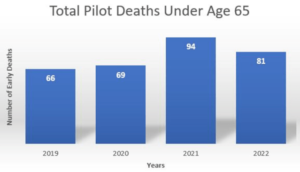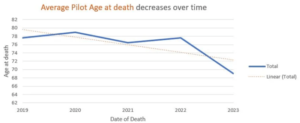Analysis of obituaries shows a 40% increase in deaths of younger pilots during 2021
Claims continue to circulate on the internet that airline pilot deaths have increased exponentially since the covid injection was mandated in early 2021. My investigation of the airline pilot deaths that appeared in the Air Line Pilot Magazine published by the Airline Pilots Association (ALPA) shows a 2.3% increase in pilot deaths in 2021 over 2020. There was a slight insignificant increase, certainly not exponential.

What is significant, however, was the 40% rise in the incidence of pilots dying prior to the normal retirement age of 65. This increase occurred in the year 2021. Until proven otherwise, the mandated covid injection is the cause.
The false claims of exponential rises in pilot deaths come from the way the deaths are reported in the ALPA magazine. They are not cumulative. And they are significantly delayed. The magazine is a monthly publication that has a section called In Memoriam. These are pilot deaths that the families of the deceased have decided to make public in honor of their deceased. For example, in the April 2023 issue, there was one death reported that occurred in May of 2019, and one reported that occurred in September of 2021. Eight were reported for 2022 and dozens through March of 2023. This makes it look like deaths are exponentially increasing. Actually, there were 464 deaths reported in 2019, 479 in 2020, and 490 in 2021.
@ALPAPilots could you please provide the necessary context? This page from your magazine is being used by those who erroneously believe covid vaccines kill. Thank you
— Peter Vanham (@petervanham) December 8, 2021
Admittedly, the deaths reported in the ALPA magazine are a small subset of what is occuring industry-wide. The magazine will only report the deaths for pilots that belonged to the Airline Pilot Association union. There are some large airlines whose pilots do not belong to ALPA, including American and Southwest. A more accurate method of gathering data would be to take the pilot seniority lists from all airlines and compare the lists from November of 2020 to the most recent seniority lists. This would take a tremendous amount of work as many of the pilots who disappeared from the lists may have retired, quit, or even moved on to a different airline. An obituary would be needed to verify the pilot died and at what age. Just going through these steps with the reported deaths in the ALPA magazine since January of 2019 through the present took hundreds of hours. I have the Excel file with links to the obituaries available to anyone who would like to see it. A few obituaries were not able to be verified as being the pilot named in the magazine.
The extrapolated Excel data shows an increase in younger pilot deaths starting in 2021:

The data also shows the average age of pilot deaths is decreasing over time:

I previously wrote a three-part article on pilot deaths titled An objective analysis of commercial airline pilot deaths as reported in the Airline Pilots Association (ALPA) magazine since 2019.
Part Two described the physiological reasons why the covid injections could be a causative factor in pilots dying younger. Since that time, it has become even more apparent that the chance of a sudden unexpected death increases significantly with booster injections. As described in Part Two in detail, a simple explanation could be activation of the complement cascade, a very aggressive membrane attack complex that is antibody-dependent. Put another way, it takes the first injection to stimulate antibody production. The booster injection can cause the previously created antibodies and the memory to quickly remake them to overreact to the billions of spike proteins that will arise from subsequent shots. This can result in a membrane attack complex that is very destructive, particularly in the heart muscle.
Another mechanism was proposed by Steven Hatfill, MD, in the summer of 2022. He found that the mRNA in the covid injections codes for the spike protein to be in what is called an open configuration. When T-cells interact with the spike protein that will be expressed on the surface of cells in this open configuration, it causes the T-cells to release highly inflammatory cytokines. This can start an escalating feedback loop that attracts even more white blood cells, resulting in more inflammation in the cardiac tissues resulting in myocarditis. Here is the link.
Another mechanism was published by Yonker, et al, in January of 2023. Here is the link. They compared vaccinated subjects that had myocarditis vs. those who did not have myocarditis. Those with myocarditis had free floating spike proteins circulating in their bloodstreams, whereas those without myocarditis did not have the circulating spike proteins. They do not explain why some have free spike proteins and others do not, they only report the findings. A possible explanation could be that with repeated booster injections, elevation of IgG4 antibodies occurs in some people. This reduces the ability of antibodies to bind to the spike proteins, allowing them to freely float. See here.
It took about two years for scientists to discover these unforeseen physiological mechanisms that explain what they expected to occur before mRNA covid-19 “vaccines” were introduced into billions of humans and thousands of pilots. Two years should have been the minimum amount of time dedicated to the safety and efficacy trials that only lasted a few months.
At the time these injections were mandated and forced into airline pilots, they were experimental, and still are experimental. The Federal Aviation Administration (FAA) guidelines prohibit the use of experimental drugs in pilots. Even after a drug is Food and Drug Administration (FDA) approved, the guidelines do not allow pilots to use the drug until a full year has passed. This allows time to identify any adverse reactions in the general population that might affect the safety of flight.
It can be weakly argued that the injection is not a drug, but a “vaccine.” However, the guidelines for vaccines state that vaccines must be FDA approved. None of the injections were FDA approved when they started going into pilots in December of 2020. Pfizer got FDA approval to make Comirnaty on 23 August 2021. Moderna got FDA approval to make Spikevax on 31 January 2022. Spikevax was not in the marketplace until 1 April 2022. Comirnaty was not available until 18 May 2022, a year and a half after the mandate.
Pfizer’s BNT162b2 injection got emergency use authorization on 11 December 2020. The very next day, the FAA stated that it was safe for commercial airline pilots to get the injection. This decision was based on the belief that the FDA and the Centres for Disease Control (CDC) had rigorously tested the injection to prove it was safe and effective. The vaccine manufacturers set up the trials and the tests, not the FDA, not the CDC. The manufacturers compile the results, supposedly overseen by a third party. The results are then pitched to the advisory committees for the FDA and the CDC. The Vaccine and Related Biological Products Advisory Committee (VRBPAC) advises the FDA. The Advisory Committee on Immunisation Practices (ACIP) advises the CDC. Some members of these committees have ties to the pharmaceutical industry. Yet they say there is no conflict of interest.
None of the shots were safe for pilots. A known adverse event of special interest (AESI) is myocarditis. In fact, the Summary Basis for Regulatory Action (SBRA) for Comirnaty requires Pfizer to track and document myocarditis with various reports at specific times due until the year 2027. An SBRA is a document that provides a comprehensive summary of the scientific and clinical data submitted to a regulatory authority – such as the FDA – for a new drug, biologic, or medical device. It serves as a basis for regulatory action, including approval or denial of the product. Here is a link to the document where you can word search “myocarditis.”
The document also requires reports on subclinical myocarditis. Subclinical means asymptomatic, implying that the pilot could have myocarditis without knowing it. Since subclinical myocarditis can result in sudden heart failure without warning, the possibility of two pilots with subclinical myocarditis being in command of a passenger aircraft at the same time is real and potentially dangerous.
I am working with US Freedom Flyers to encourage the FAA to prohibit any further mRNA injections and to take steps to screen pilots for possible subclinical myocarditis.
Author: Dr. Kevin Stillwagon (retired chiropractor, airline captain, inventor, author and lecturer)
yogaesoteric
July 8, 2023
